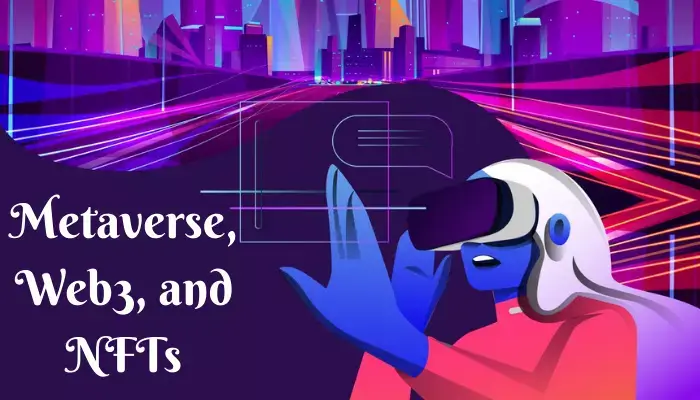What is the Difference Between Web3 and the Metaverse?
While Web3 is a decentralized version of the internet, the Metaverse is a virtual universe linked to many real-world features. Both systems focus on the creation of decentralized infrastructure and enabling the creation of trustless digital assets. Facebook’s entry into the Metaverse is the latest example of this. Read on for more information. Listed below are some of the main differences between Web3 and the Metaverse.
Table of Contents
Web3 – Decentralized Version Of The Internet
When we hear Web3 or blockchain, they automatically come to mind. However, the terms are often confused. While the Web is already decentralized, the Metaverse is the future of the internet. This article will discuss the differences between the two. In this article, we will look at how Web3 is decentralized compared to the current version of the internet. This will help you understand the benefits of Web3 and the Metaverse and the limitations.
The Web3 concept involves replacing third-party systems with decentralized applications. As a result, there will be no single entity to control the flow of information. With Web3 and its decentralized infrastructure, all participants will have their systems and servers and be able to vote on rules. This is the third evolution of the internet. We are already seeing the effects of this technology on the financial and social world.
The Metaverse and Web3 are not the same, but the two are closely related. Web3 is a decentralized version of the internet, while the Metaverse is a virtual world mainly centralized. The Metaverse is different from the Web and only works on a free network like Web3.
Web3 and the Metaverse are emerging technologies that address problems with the current internet. However, some of them are already in use. Despite their relative lack of widespread adoption, some of these technologies are currently under development. Web3 is already one of the fastest-growing trends in technology. Although its deployment will take some time, some are already in production, including the Metaverse.
Metaverse – Digital Universe
The Metaverse is a digital environment linked to many real-world features. People who enter this virtual environment can “live” in a digital avatar. In the Metaverse, they can communicate with friends, buy and sell digital assets, and take virtual trips to places in virtual places that may be imagined or real, but there is no way to tell which. The potential of the Metaverse is immense, as people will be able to experience an unlimited number of different scenarios simultaneously.
The Metaverse is a hypothetical digital universe that offers parallel experiences and potential for enhanced abilities to people living in the real world. The Metaverse resembles the robotic-manufactured world of movies such as The Matrix. Virtual reality headsets and motion-tracking machinery can produce realistic renderings of the Metaverse. Visitors are typically anonymous virtual avatars who lead pseudo-anonymous lives.
While the metaverse concept is intriguing, it is also challenging to understand. It is difficult to determine precisely what it means in a new digital world and how it could connect with the real world. However, the idea of a digital universe linked to many natural world features has been gaining momentum in recent years, as many big tech companies talk about it. It is envisioned that our current internet experience is two-dimensional. In contrast, the future version of the internet will be three-dimensional, with users “walking” through it with glasses or headsets.
As the Metaverse is a parallel reality to the real world, it is not yet clear how exactly it will work. Several theories make the Metaverse a reality, but no concrete examples exist. Most importantly, the Metaverse will be where people can live in a digital version of the real world.
NFTs Allow For Trustless Ownership Of Digital Assets In Metaverse
The blockchain foundations of NFTs enable anonymous individuals to transfer and use digital assets anonymously. This makes the system fair for all parties involved and further enhances the freedom of those who do not have equal access to financial services. For instance, women in Africa and the Middle East are often denied access to passports or birth certificates. NFTs stored on a blockchain could act as a digital passport or ID and serve as proof of residency.
A notable example of an NFT is the “Quantum” by artist Kevin McCoy. The digital data was converted into crypto collections and made available for purchase on the blockchain. A similar process is being done with NBA cards. But unlike a virtual asset, these cards cannot be tracked. Instead, they use a rating system. However, they cannot be tracked digitally. Unlike NFTs, NBA cards cannot be tracked or traced.
Besides the blockchain, NFTs can be used for identity authentication, certification, and physical assets. They can be used for concert tickets, coupons, and other physical assets. In addition, NFTs can be used to measure fans’ engagement and interaction with the Metaverse. NFTs are an integral part of the metaverse ecosystem and are the backbone of its economy.
NFTs are the key to making the Metaverse a reality. Not only do they help users transfer their items between platforms, but they also make it easier to customize digital assets. Imagine a world where virtual items could be purchased or sold with NFTs. That kind of access could even enable people to participate in play-to-earn video games. This new Metaverse has the potential to become a lucrative industry for investors, enterprises, and fans alike.
Read More: Why is Facebook So Interested in Having a Metaverse?
Facebook’s Entry Into Metaverse
It’s hard to say what to make of Facebook’s entry into the Metaverse, but if you’re looking for an example of how the company is redefining the internet, look no further than Second Life. This famous online virtual world lets people connect, trade assets, and earn cryptocurrency. Philip Rosedale created the platform in 2003 before Bitcoin was even a thought. Facebook’s move into the Metaverse could give the social network a competitive advantage.
Although Facebook just announced its entry into the Metaverse, it has been laying the foundations for some time. The company has been developing private applications, but the interest of institutions in building a metaverse is much greater than their traditional interest in acquiring user data. Facebook, after all, is the first and only platform to gather data on the lives of its users. The company has also dedicated billions of dollars to the project.
The company’s entry into the Metaverse has been met with controversy. Some have speculated that it will engulf users in endless scrolling content. This technology could also track people’s facial movements or even read their brains in the future. Indeed, Facebook recently shut down facial recognition tech on its central platform but said it’d use it in the Metaverse. In short, the company is attempting to become a “metaverse company” through which users can create their content.
The metaverse concept is still a few years away from becoming widespread, but Facebook’s entry into the Metaverse will bring a wave of investment and talented developers to the platform. The company’s entry into the Metaverse will likely increase Facebook’s scrutiny of the company. As Facebook has failed to protect its users from abuse, a former employee has leaked thousands of documents that show the company’s lack of privacy and security practices.
Bitcoin’s Entry Into The Metaverse
If we define “Metaverse” as a mix of blockchain technology, virtual reality, and micropayments, we’ll look at a world resembling the real one. In essence, this new digital world is a virtual world that uses blockchain technology to fuel its economy. Moreover, it can be described as a world with a virtual economy, one that is driven by cryptocurrencies.
The Metaverse is a virtual universe in which people can interact and do almost anything they like. Some of these virtual spaces include free-combat zones and huge hovering overhead light shows. Many people have expressed their excitement at the concept of using Metaverse for online contact. They’re even creating virtual worlds where they can gather together, play, work, or complete. In a sense, the whole world is at your fingertips, and your mind is in control.
A real-life metaverse can never perfectly mirror reality, but blockchain-based metaverses can come close. While many of these platforms are still working on the technology to enable people to interact with their virtual surroundings, you can at least invest in the technology by following some fundamentals. According to PwC, virtual reality could boost the global economy by $1.5 trillion by 2030, and companies like Alphabet Inc. have already made investments.
In addition to the ICO, many other projects are in the works in the crypto space. For example, Fold AR is an augmented reality game that uses Niantic’s real-world mapping tools. Fold AR is also a blockchain-based game that uses a feature to reward users with Bitcoin. The goal is to encourage people to play and earn Bitcoin through the virtual world. The Metaverse is the next-generation internet. This is why Bitcoin’s entry into the Metaverse is so essential.






Leave a Reply